Lec 02. Traditional Methods for ML on Graphs
<Course Outline>
- Traditional Feature-based Methods: Node
- Traditional Feature-based Methods: Link
- Traditional Feature-based Methods: Graph
2.1 - Traditional Feature-based Methods: Node
Traditional ML Pipline
: is about designing proper features!
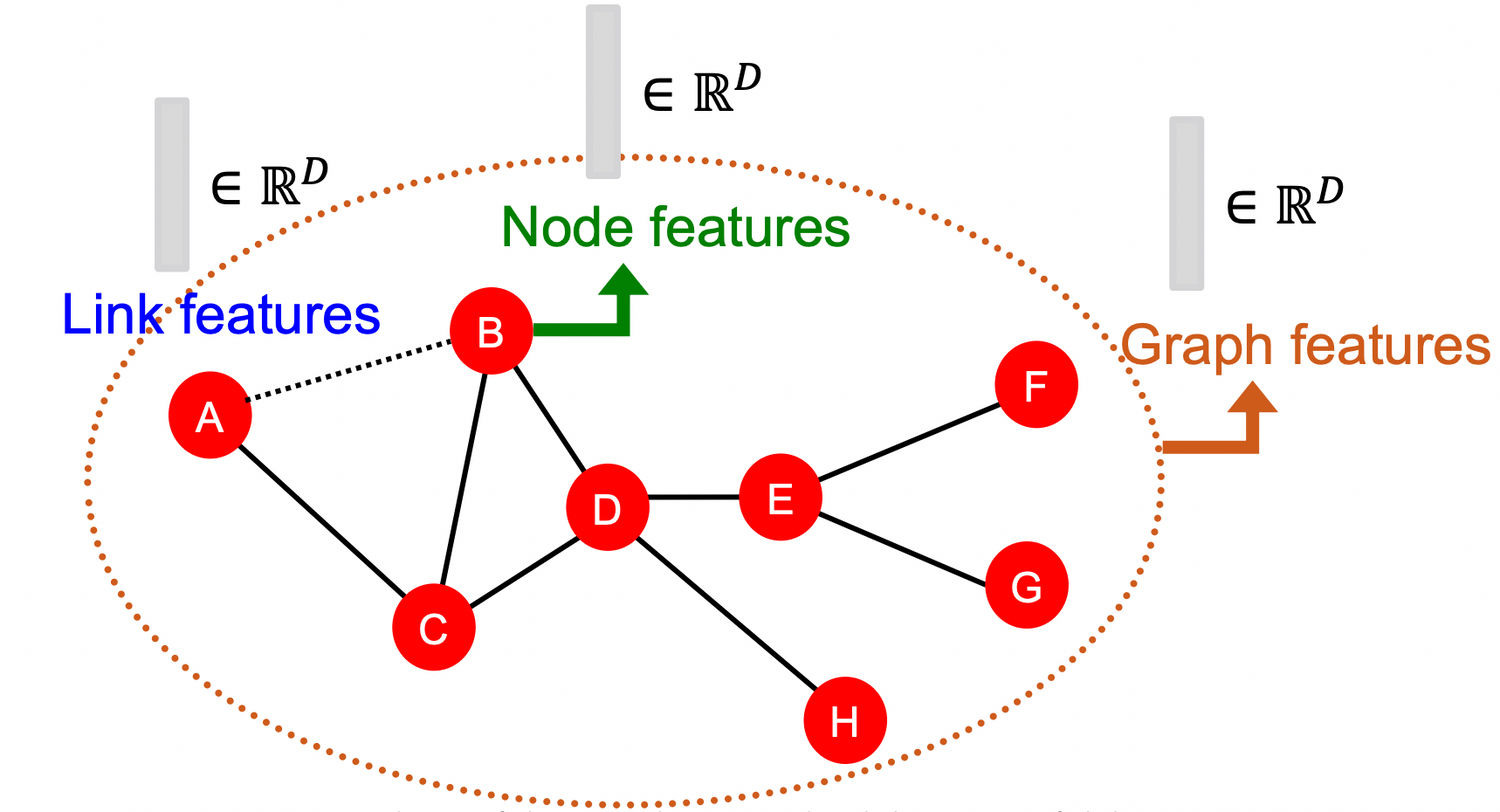
- Traditional ML : hand-designed features 을 이용
- Design features for nodes/links/graphs ⇒ 효과적인 feature representation 을 찾는 것이 performance ↑
- structural feature(ex. positional...) → Graph-level prediction
- attributes and properties of node → Node / Link level prediction
Machine Learning in Graphs
- Goal: Make predictions for a set of objects
- Design choices:
- Features : d-dimensional vectors
- Objects : Nodes, edges, sets of nodes, entire graphs
- Objective function : What task are we aiming to solve? (풀고자 하는 문제에 따라 다름)
💡 Given : ⇒ learn a fuction
Node-level Tasks and Features
Goal: Characterize the structure and position of a node in the network using
- Node degree
- Node centrality
- Clustering coefficient
- Graphlets
1) Node degree
degree : the node 가 가진 edge ( = neighboring nodes) 의 수
- 모든 이웃 노드를 동일하게 취급 → 이웃 노드의 importance를 capture 할 수 없음
- 한계) 해당 feature만 사용하면, 모델이 같은 차수를 갖는 노드를 모두 똑같이 예측할 것임
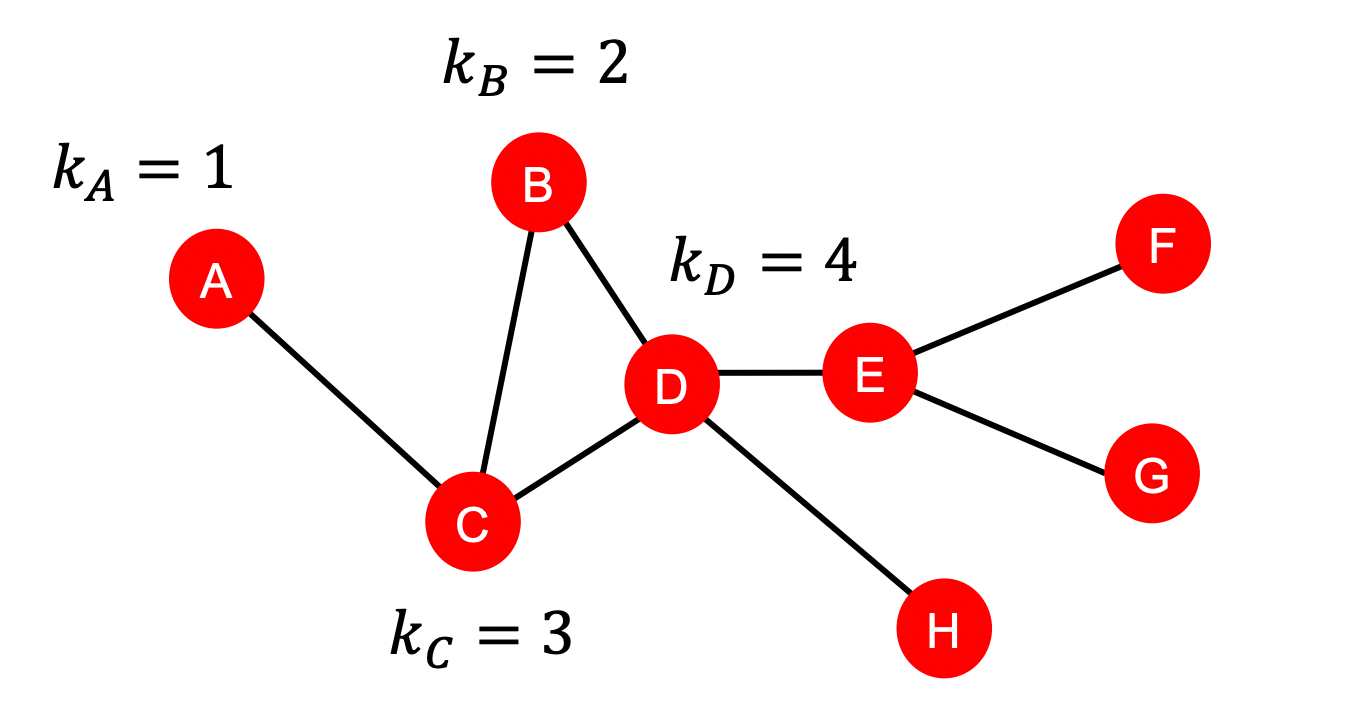
2) Node Centrality
: 노드 의 이웃 노드의 centrality의 합이 크면 importance ↑
Node Centrality : 그래프에서 노드가 얼마나 중요한지 고려
- Different ways to model importance
- Eigenvector centrality
- Betweenness centrality
- Closeness centrality
- and many others…
Eigenvector centrality
Q) 여기서 centrality는 무엇인가(어떤 값인가)? 결정되지 않은 값인가?
A) Eigenvalue-eigenvector 방정식을 푼다 = 고유값 분해를 통해서 고유값 와 고유벡터 를 동시에 구해야하는 연립방정식인 “eigenvalue problem”을 해결하는 것이므로 → 와 가 동시에 결정됨.
centrality of node = the sum of the centrality of neighboring nodes

c : eigenvector ⇒ leading eigenvector : used for centrality
Betweenness centrality
: 임의의 노드 → 로 가는 최단 경로에 노드 가 속한 경로가 많을수록 importance ↑

Closeness centrality
: 다른 모든 노드 에서 → 로 가는 최단 경로가 짧을 수록 importance ↑
= 가장자리에 위치한 노드일수록 다른 노드로부터 거리가 멀어짐 ↑

3) Clustering Coefficient
: measures node degree & local structure around the nodes

→ 연결 가능한 노드 중에서 실제로 몇개가 연결되어 있는가?
0 : 하나도 연결 X , 1 : 연결 가능한 모든 노드를 연결
Example )

: = 1 ⇒ = 4 (빨간색 노드=이웃노드 개수) , 이웃노드는 총 6개의 엣지로 서로 연결되어 있음
💡 Observation : Clustering coefficient counts the #(triangles) in the ego-network
ego-network = 노드 와 그 주변 노드를 의미 = neighborhood network around a given node

, 3 = # of triangle
→ We can generalize the above by counting #(pre-specified subgraphs, i.e., graphlets).
4) Graphlets
Rooted connected non-isomorphic subgraphs:
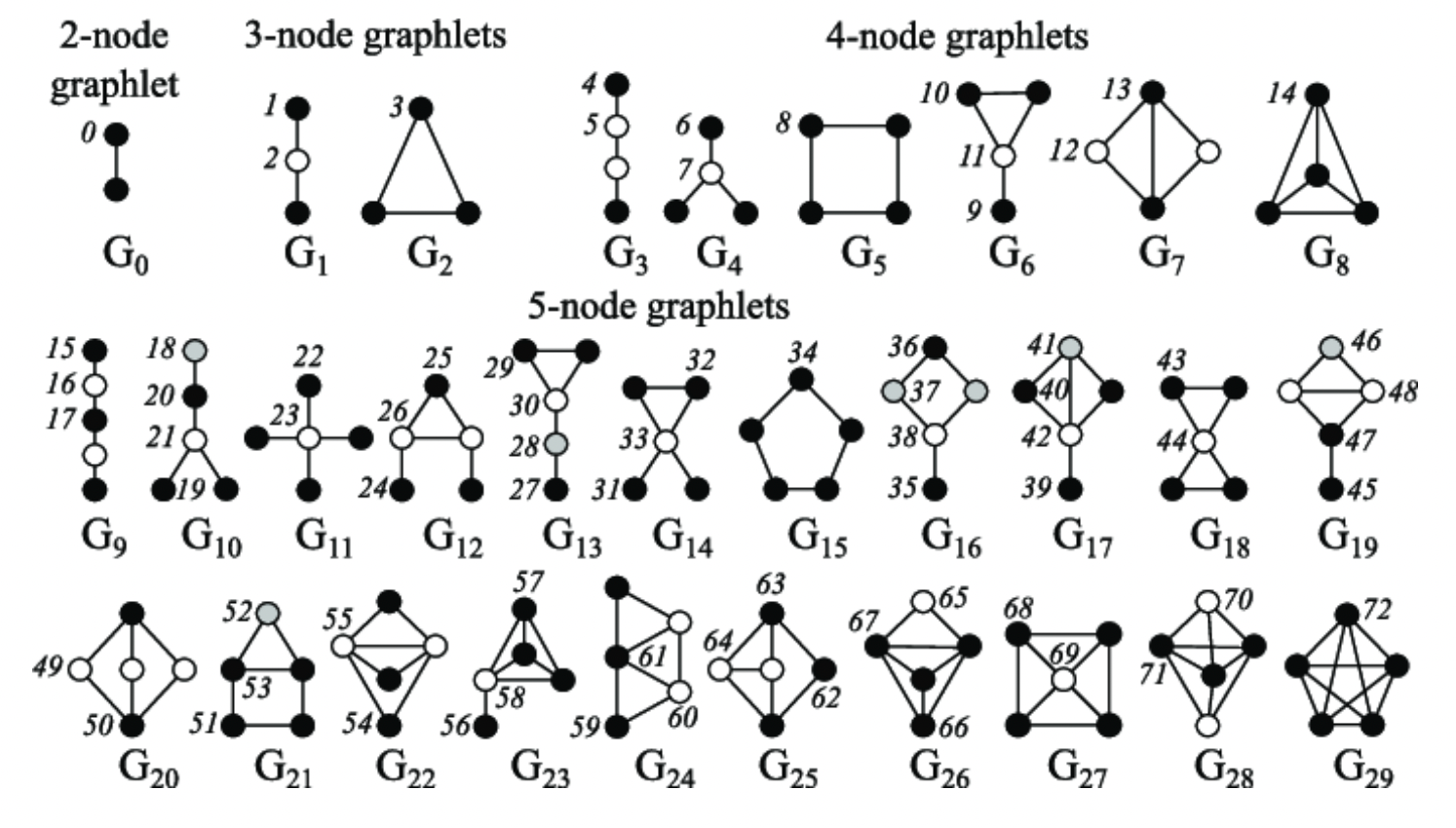
+) 3-node graphlets에서 1번 노드 =/= 2번 노드 지만, 1번 노드는 2번 아래에 있는 노드와는 (회전하면) 같은 노드로 볼 수 있다. → 1번과 2번은 non-isomorphic , 1번과 2번 아래의 노드는 isomorphic 하다고 할 수 있다.
Graphlet Degree Vector (GDV)
: A count vector of graphlets rooted at a given node
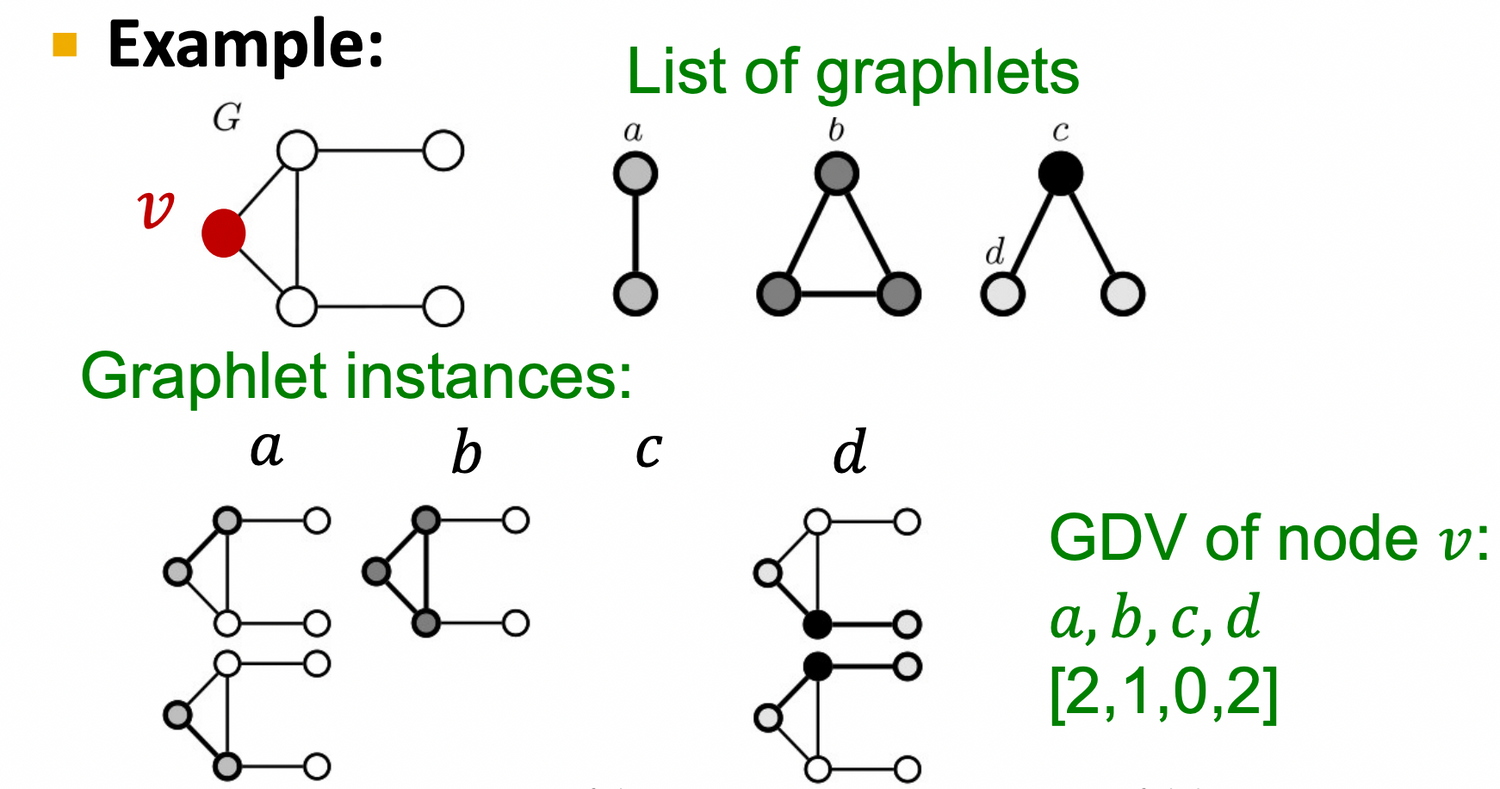
Considering graphlets on 2 to 5 (노드 2개짜리 ~ 5개짜리 graphlet) nodes we get :
- Vector of 73 coordinates is a signature of a node that describes the topology of node's neighborhood → 총 73개의 서로 다른 graphlet이 존재할 수 있음 → graphlet이 노드 이웃의 위상 구조 설명
- Captures its interconnectivities out to a distance of 4 hops → 5개짜리 graphlet은 노드 로부터 4hop 떨어진 (length = 4) path가 몇개 있는지 count하는 것!
- 두개 노드를 가지고 비교하는 node degrees or clustering coefficient 보다 더 자세한 local topological similarity를 측정 가능!
< Summary >
- Degree : counts #(edges) that a node touches
- Clustering coefficient : counts #(triangles) that a node touches.
- GDV : counts #(graphlets) that a node touches
2.2 - Traditional Feature-based Methods: Link
Link-Level Prediction Task
= 존재하는 link에 기반하여 새로운 link를 예측하는 task
- At test time : 존재하는 link를 제외한 모든 노드 pair를 rank → Top K개의 node쌍에서 link가 발생할 것이라고 예측
- key 🔑 : design features for a pair nodes !
단순히 노드 pair의 feature를 concat해서 train하는 방법은 좋지 X → 두 노드 사이 관계에서 중요한 정보를 잃을 수 있음.
Two formulations of the link prediction task:
- Links missing at random: 랜덤하게 제거한 링크를 예측
- Remove a random set of links and then aim to predict them
- static network 예측에 유리
- ex) protein-protein interaction network
- Links over time: 시간에 따라 예측
- Given : a graph on edges up to time ( 와 사이에 발생한 노드)
- output : a ranked list L of links (not in ) that are predicted to appear in (다음 step ~ 에 발생할 노드의 랭킹을 예측)
- Evaluation (학습 방법) :
- : # new edges that appear during the test period
- L에서 top n 개의 edge를 예측 → 실제로 발생한 edge와 비교하여 count correct edges
- 시간에 따라 evolve하는 네트워크 예측에 유리
- ex) social media network, citation network ...
Link-Level Features
1) Distance-based feature
= 두 노드 사이의 최단 경로를 feature로 사용

한계 ) 두 노드 사이의 distance는 체크할 수 있지만, degree of neighborhood overlap 은 capture X :
- 예를 들어, Node pair (B, H) 는 B→ D → H , B → C → H 두 종류의 최단경로를 가짐
- pairs (B, E) and (A, B) 같은 경우에는 1 개의 최단경로를 가짐
- 하지만 이 둘을 똑같이 취급함. ⇒ Strength of connection를 capture하기 위해서 2)가 등장
2) Local neighborhood overlap
= 두 노드의 공통된 이웃을 계산
-
Common neighbors:
-
Jaccard’s coefficient:
- |N(v_1)∪N(v_2)| 가 normalize하는 역할을 했을 뿐, 개념은 1)과 같음.
-
Adamic-Adar index:
- practically used
- : degree of node
- 엣지가 많은 노드보다, 엣지가 적은 노드와 연결되었을 때 더 큰 점수를 부여
한계 ) 공통된 이웃이 없을 경우 항상 0을 출력 → 2hop보다 멀리 떨어진 노드는 항상 0!
⇒ 이러한 한계를 보완하기 위해 3)이 등장
3) Global neighborhood overlap
Katz index : count the number of paths of all lengths between two nodes.
💡 How to compute #paths between two nodes?
⇒ Use powers of the graph adjacency matrix!
specifies #paths of length 1 (direct neighborhood) between and .
& specifies #paths of length .
Proof ) How to compute ?
노드 u와 v가 2-hop만큼 떨어진 path를 가지기 위해서는
→ u로부터 1의 path를 가지는 임의의 노드 i 가 존재해야함 * 다시 i로부터 v로 가는 path가 존재해야 함.
둘중에 하나라도 존재하지 않으면 곱셈했을 때 0이 나오게 된다.
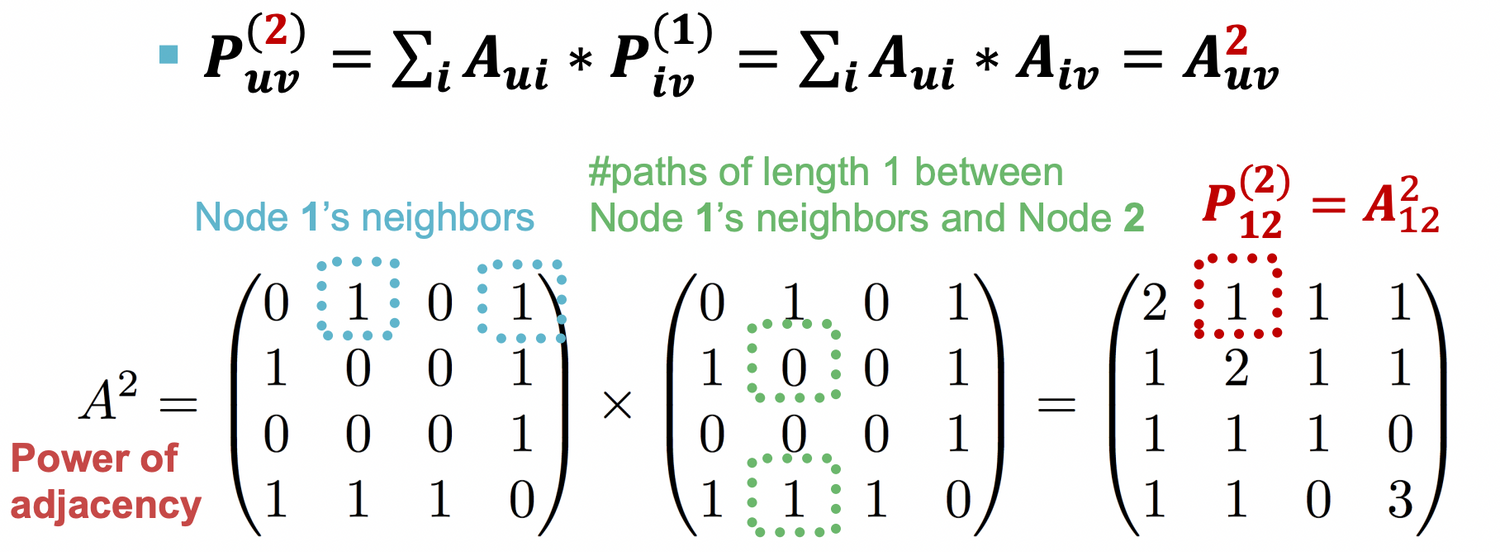
⇒ Katz index between and is calculated as

- discount factor = length에 따라 exponentially 감소하면서 longer path에 더 낮은 importance를 부여하게 된다.
- Katz index matrix is computed in closed-form:

2.3 - Traditional Feature-based Methods: Graph
How do we create feature vectors from graphs in a sccalable & interesting way?
- Goal: We want features that characterize the structure of an entire graph.
전체 그래프 구조의 특성을 반영할 수 있는 feature 표현을 찾는 것.
Background : Kernel Methods
Idea : feature vector 를 디자인X ⇒ Kernel 을 디자인 O
A quick introduction to Kernels:
-
Kernel : measures similarity b/w two graphs
-
Kernel matrix must always be positive semidefinite
(i.e., has positive eigenvals) -
There exists a feature representation such that
-
kernel을 사용했을 때 👍 : doesn’t even need to be explicitly created for us to be able to compute the value of the kernel → Once the kernel is defined, off-the-shelf ML model, such as kernel SVM, can be used to make predictions. (커널이 정의되면 커널 SVM과 같은 기성 ML 모델을 사용하여 예측할 수 있습니다.)
Graph Kernels
- Goal: Design graph feature vector
- Key idea: Bag-of-Words (BoW) for a graph
- Both Graphlet Kernel and Weisfeiler-Lehman(WL) Kernel use
Bag-of-*representation of graph.
- Both Graphlet Kernel and Weisfeiler-Lehman(WL) Kernel use
종류
- Graphlet Kernel [1] : Bag-of-graphlets
- Weisfeiler-Lehman Kernel [2] : Bag-of-colors
- Other kernels are also proposed in the literature (beyond the scope of this lecture)
- Random-walk kernel
- Shortest-path graph kernel
- And many more…
1) Graphlet Features
- Key idea: Count the number of different graphlets in a graph. 💡 Note: node-level features에서 배운 graphlets 정의와 다르다 !
- The two differences are: graplhet이 connected & rooted 되어 있지 않다
Definite of graphlet in graphlet kernel
: Let be a list of graphlets of size
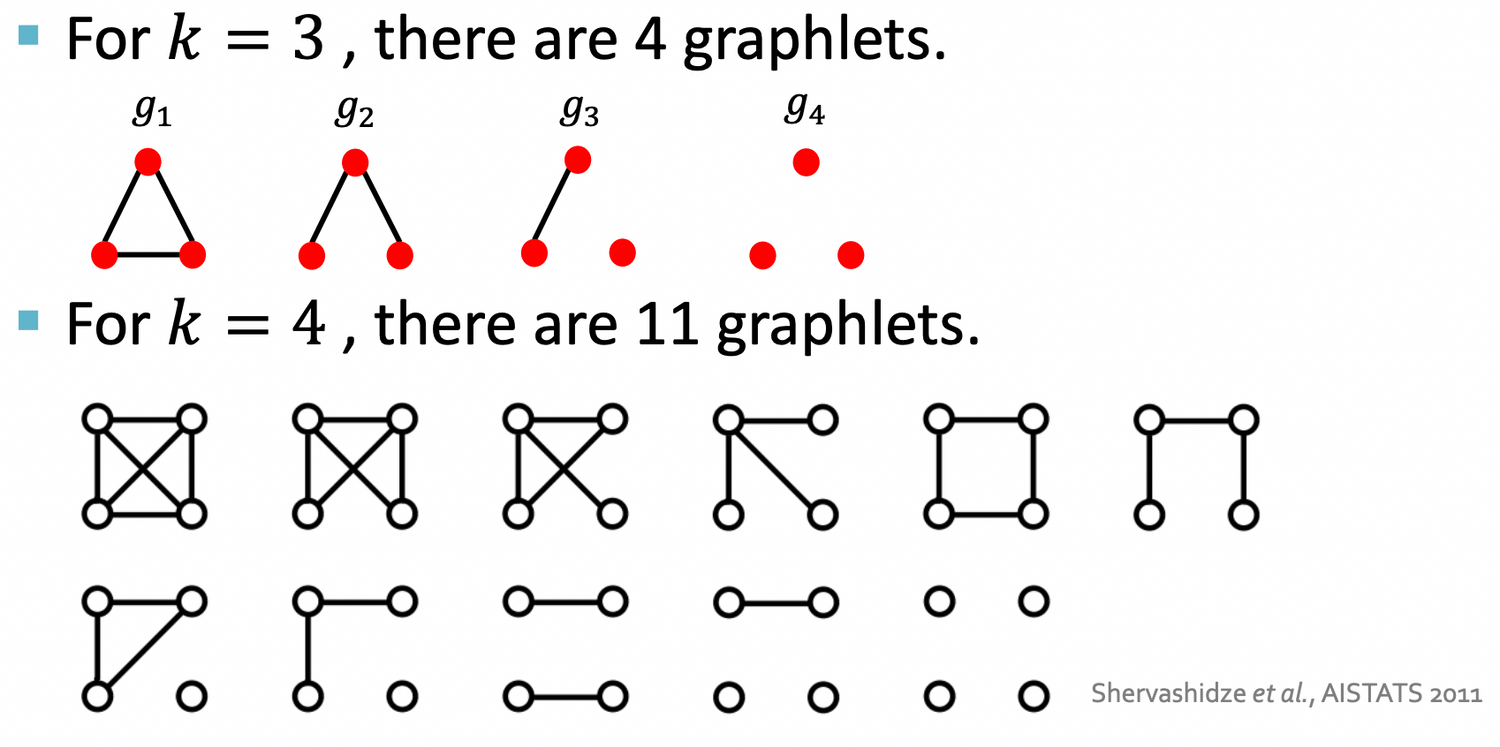
Given graph , and a graphlet list , define the graphlet count vector as
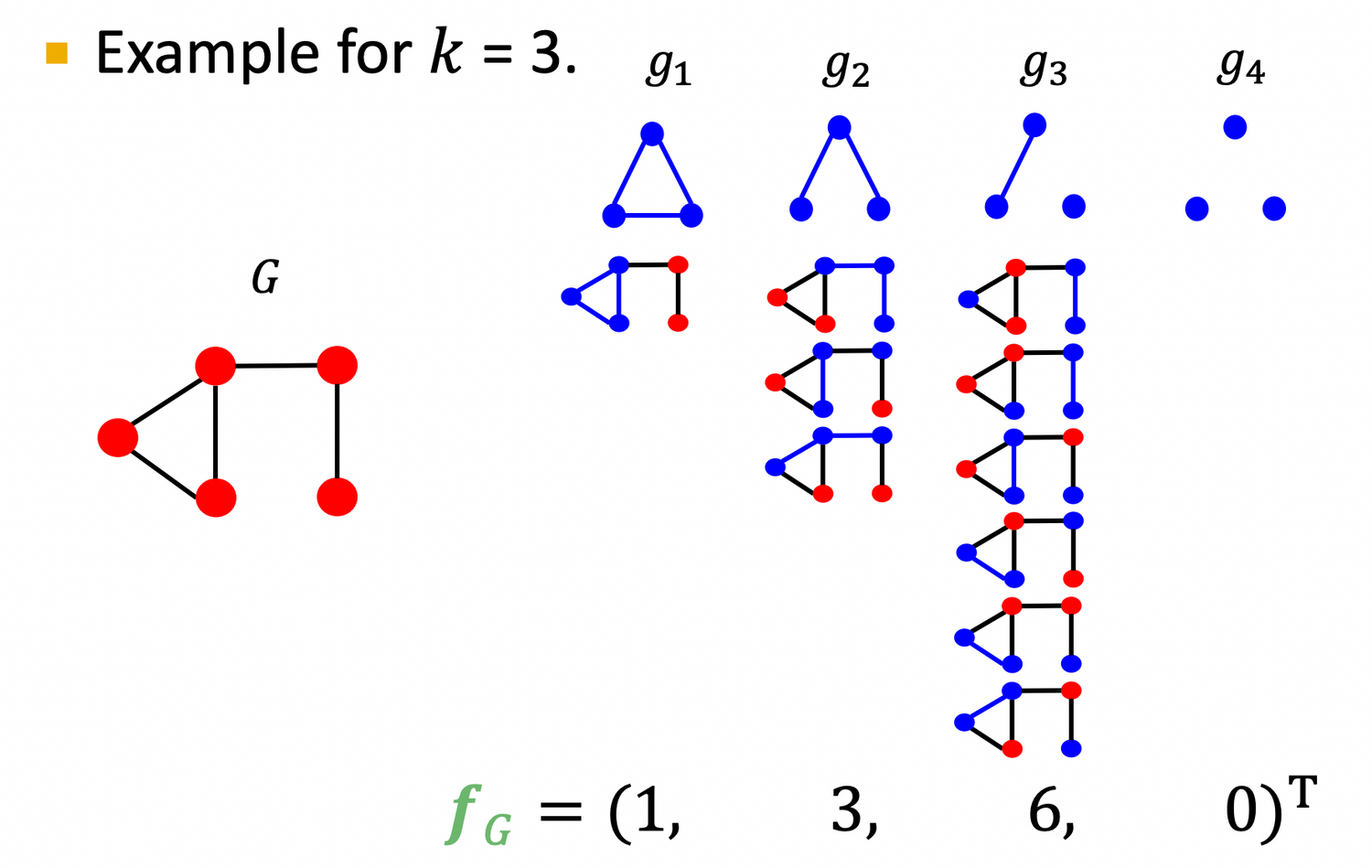
Given two graphs, and , graphlet kernel is computed as
- Problem: if G and G’ have different sizes, that will greatly skew the value.
- Solution: normalize each feature vector

- Limitations : Counting graphlets is expensive!
- 논문읽기
🥺 how can we design more efficeint kernel? ⇒ W-L Kernel
2) Weisfeiler-Lehman Kernel
- Goal: design an efficient graph feature descriptor
- idea: use neighborhood structure to iteratively enrich node vocabulary.
- Bag of node degrees를 one-hop ~ multi-hop으로 일반화 한 것!
- Algorithm to achieve this:
Color Refinement
Example of color refinement given two graphs
Given : A graph with a set of nodes
-
Assign an initial color to each node . : 모두 같은 색으로 초기화

-
Aggregate neighboring colors

-
Hash aggregated colors


-
이를 K번 반복 (여기서는 K=3)
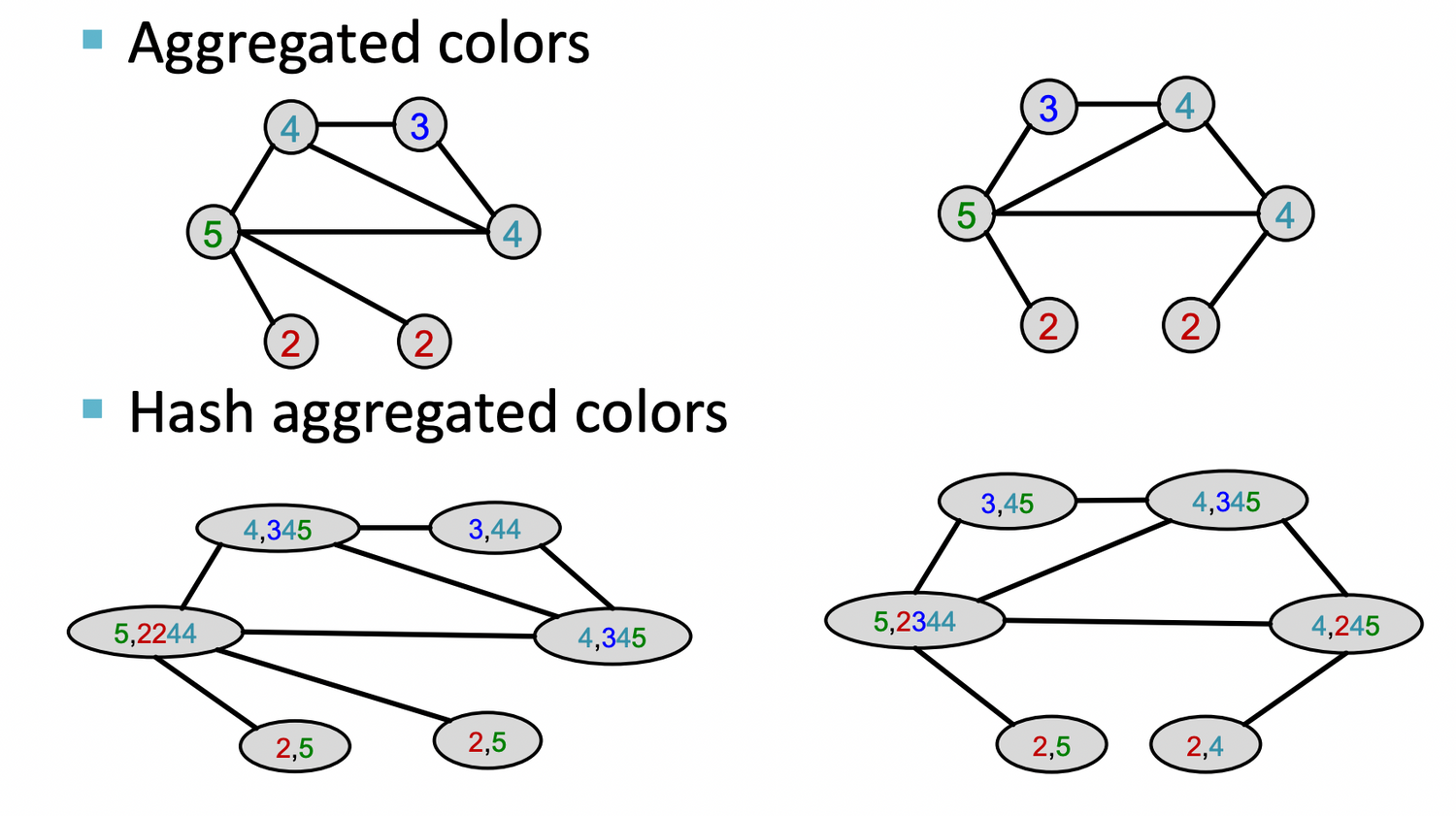

-
After K steps of color refinement, WL kernel counts number of nodes with a given color.
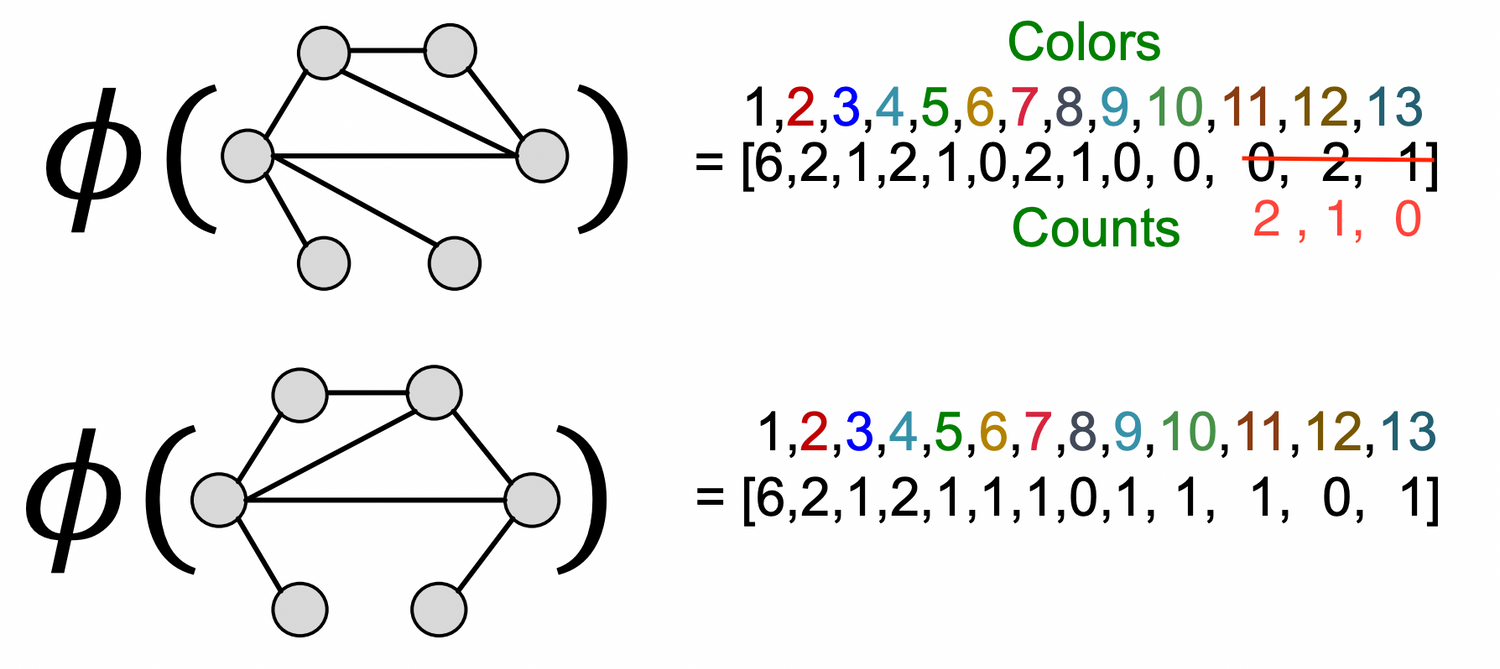
: summarizes the structure of K-hop neighborhood
-
The WL kernel value is computed by the inner product of the color count vectors:
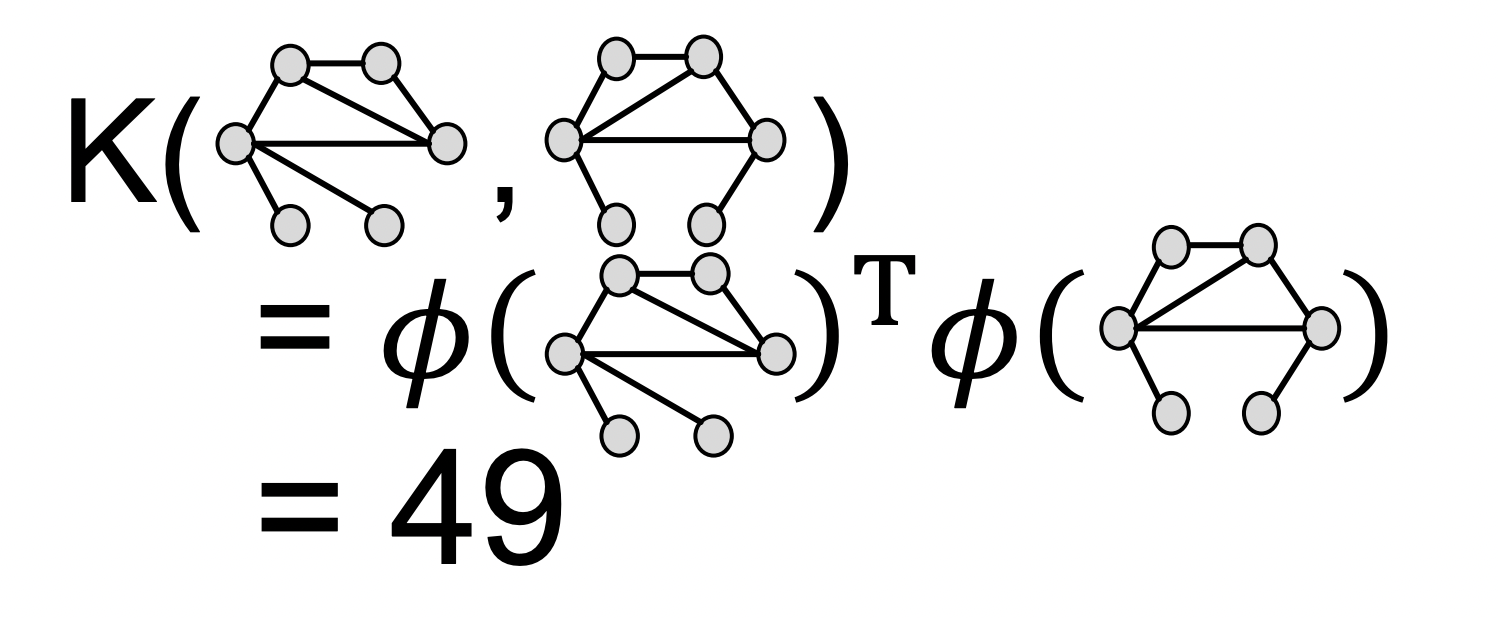
WL kernel is computationally efficient.
- 각 step에서 이웃의 color를 집계하는데 필요한 time complexity : linear in #(edges)
- 각 노드에서 이어진 모든 엣지를 따라 집계 + hashfunc. 적용 하기만 하면 됨
- kernel value 를 계산하기 위해서 두 그래프에 나타난 색깔이 tracked될 필요가 있는데
- 색깔의 개수는 노드 개수를 넘지 않으므로 #(colors) ≤ #(nodes)
- Counting colors : linear-time of #(nodes)
⇒ In total, time complexity is linear in #(edges).
cf> Closely related to Graph Neural Networks (as we will see!)

파이썬과 머신러닝을 공부하다가 님의 블로그를 거쳐서 여기까지 왔습니다. 자연어 처리와 머신러닝을 함께 공부하면서 개척해가면 서로 성장할 수 있을 것 같아서 글을 남깁니다. 저는 '렉스코드'라는 회사를 검색할 때 나오는 대표이고 어렵지 않게 전화번호나 이메일은 찾으실 수 있을 것 같습니다. 끝으로 좋은 내용 감사드립니다.